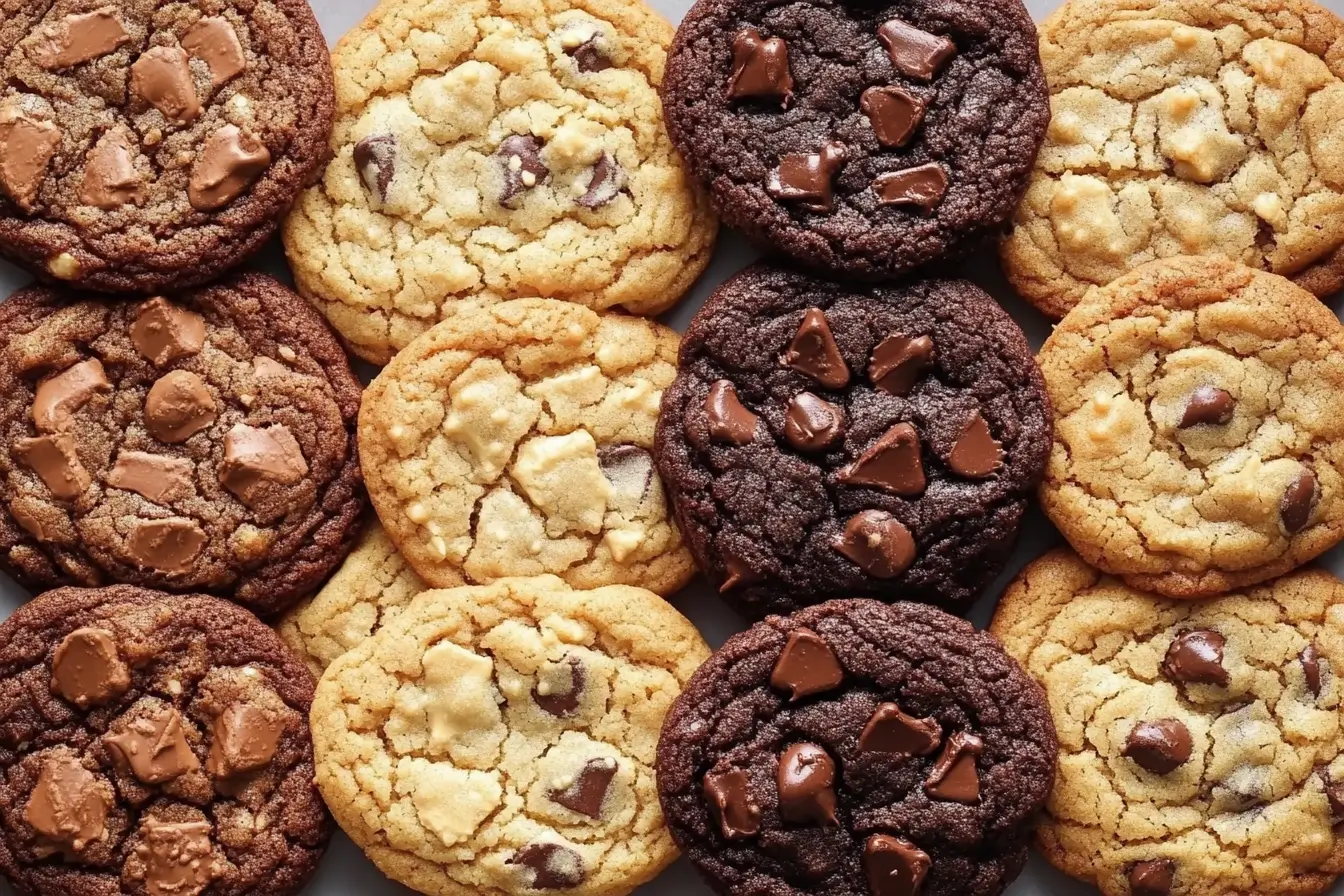Ah, chocolate chip cookies. Is there any dessert more iconic? Whether you’re biting into a crisp, buttery edge or sinking your teeth into a soft, gooey center, the humble chocolate chip cookie has been a fan favorite in the U.S. for generations. But let’s settle an important debate today: what’s the real difference between crunchy and chewy chocolate chip cookies?
If you’ve ever wondered why some cookies snap while others bend, or what magical alchemy turns cookie dough into one texture versus another, grab some milk (and maybe a cookie or two for research). Let’s get into it.
Before we dive into the finer points, if you’re looking to elevate your cookie game, don’t miss our guide to baking irresistible chocolate chip cheesecake cookies. These gems are a cheesecake lover’s dream come true!
The Ingredients Make All the Difference
Before we talk technique, let’s break down the key ingredients that make up a chocolate chip cookie. You’ve got your basics:
- Flour
- Butter
- Sugar
- Eggs
- Baking Soda (or Powder)
- Salt
- Vanilla Extract
- Chocolate Chips (duh)
Now, here’s the kicker: slight changes in the ratio of these ingredients can completely flip the script on your cookies. Let’s dive into what each ingredient does and how tweaking it can make your cookies crunchy, chewy, or somewhere in between.
From flour to sugar to butter, every ingredient plays a role in defining your cookie’s personality. Slight tweaks can transform a cookie from crisp and snappy to soft and chewy.
Butter: The Key Player
Butter is more than just a flavor booster—it sets the stage for texture. Creaming softened butter creates air pockets that result in crispy edges, while melted butter contributes moisture for chewy centers. If you’re experimenting with rich and creamy treats, check out how cream cheese elevates cookies in our article about refrigerating cream cheese-filled cookies.
Butter: The Foundation of Texture
Butter is the star player when it comes to cookie texture. It provides moisture, richness, and flavor. But the way you handle your butter—whether it’s melted, softened, or creamed—can create drastically different results:
- For Crunchy Cookies: Use softened butter and cream it with the sugar. This traps air into the dough, giving your cookies a lighter texture and helping them crisp up in the oven.
- For Chewy Cookies: Melt the butter before mixing. This gives the dough more moisture, which translates into that irresistible chewiness.
Sugar Wars: Brown vs. White
Sugar doesn’t just sweeten cookies—it plays a huge role in the texture, too. Here’s why:
- White Sugar: Creates a crispier cookie because it doesn’t hold moisture well. More white sugar = more crunch.
- Brown Sugar: Contains molasses, which keeps cookies moist and adds that signature chewiness. More brown sugar = softer cookies.
Pro Tip: If you want a cookie that’s chewy in the center but crisp on the edges, try a 50/50 mix of brown and white sugar. Trust me, it’s the best of both worlds.
The balance between brown and white sugar is critical. Brown sugar, with its molasses content, locks in moisture, creating a soft texture, while white sugar encourages crispiness. For a delightful combination of cheesecake and chocolate chip flavors, try incorporating these textures into calorie-conscious cheesecake cookies.
Why Temperature Matters in Cookie Baking
Here’s the thing about baking: temperature is everything. From your oven’s heat to the temperature of your ingredients, small details can make a big difference.
- Room-Temperature Ingredients: Butter and eggs should ideally be at room temperature unless a recipe says otherwise. This helps everything mix evenly.
- Preheating Your Oven: Always preheat your oven to ensure consistent baking results. A too-cool oven will lead to cookies spreading too much, while an overly hot oven might burn the edges.
- Cooling Between Batches: If you’re baking multiple batches, let the baking sheets cool between rounds. Hot pans will make your dough spread faster, leading to thinner, crispier cookies.
The Science Behind Cookie Spread
Ever wonder why some cookies spread thin while others puff up? It all comes down to a few key factors:
- Butter Content: More butter or melted butter leads to more spreading. This is great for chewy cookies but can make crispy cookies overly thin.
- Flour Ratio: A higher flour-to-liquid ratio reduces spreading, creating thicker cookies.
- Chilling Dough: Cold dough spreads slower, which is why chilling dough before baking is a common tip for achieving thicker cookies.
Flour: Structure and Balance
Flour is the backbone of any cookie recipe, but the type and amount of flour can affect how your cookies turn out.
- More Flour: Makes cookies sturdier and drier, which leans towards crunchiness.
- Less Flour: Leads to softer, spread-out cookies that are perfect for chewiness.
Also, using bread flour (instead of all-purpose) can boost chewiness because it has a higher protein content, which helps build that stretchy texture.
Eggs: The Binding Agent
Eggs might seem like a simple ingredient, but they play a huge role in determining whether you end up with crunchy or chewy cookies. Sure, they’re great at binding the dough together, but how you use them can totally change the texture.
If you’re aiming for soft, chewy cookies, try adding an extra egg or just an additional yolk. The extra moisture keeps the cookies soft and gives them that bendy, gooey center. Perfect for Team Chewy fans!
On the flip side, if you want cookies with a crisp, rich bite, reduce the number of eggs or stick to just the yolks. This tweak makes the dough denser and helps create a firmer, buttery texture. Pair this method with other crisp-boosting factors like white sugar, and you’re golden—literally.
So, whether you’re team crunchy or chewy cookies, eggs are your secret weapon to baking perfection!
Baking Soda vs. Baking Powder
When it comes to baking, the difference between baking soda and baking powder might seem small, but it’s a game-changer for your cookie texture. Both are leavening agents, but they work differently to influence whether you get crunchy or chewy cookies.
Baking soda reacts with acidic ingredients (like brown sugar or yogurt) to produce carbon dioxide. This reaction causes the dough to spread out in the oven, which is why baking soda is often used for softer, chewier cookies. If you’re Team Chewy, this is the ingredient you’ll want to highlight.
On the other hand, baking powder contains its own acid and doesn’t require an external acidic ingredient. It creates a puffier dough, which bakes into thicker cookies with a crispy outer layer. This makes baking powder ideal for fans of crunchy cookies.
Now you know—choosing the right leavening agent is key to mastering your cookie goals!
How Baking Techniques Impact Texture of Crunchy or Chewy Cookies
Even if you’re working with the same ingredients, your baking method can make or break your cookie dreams.
Chilling the Dough
Want a chewier cookie? Chill your dough. Cold dough spreads less in the oven, which means thicker cookies with softer centers. No chill? Expect thinner, crispier cookies.
Baking Time
This one’s huge. A minute or two can completely change your cookie’s vibe:
- Crunchy Cookies: Bake longer at a lower temperature (think 325°F) to dry them out more.
- Chewy Cookies: Go for a shorter bake time at a higher temp (around 350°F).
Oven Rack Position
This might sound nitpicky, but it matters. Baking on the middle rack gives you even heat, which is perfect for balanced cookies. The top rack can make cookies crispier, while the bottom rack might make them too soft.
Personal Preferences: Which Team Are You On?
Let’s be real—this debate is personal. Some folks can’t live without the crunch of a cookie dipped in milk, while others (like me!) want their cookies to practically melt in their mouths.
Here’s a quick cheat sheet to figure out which team you’re on:
- Team Crunchy: You love cookies with golden, almost caramelized edges and that satisfying snap when you break them in half.
- Team Chewy: You’re all about the soft, gooey center that sticks to your teeth just a little (in the best way possible).
How to Make the Perfect Chewy Chocolate Chip Cookies
If you’re all about that satisfying snap, here’s how to whip up the ultimate crunchy chocolate chip cookies. First, skip the brown sugar entirely and use only white sugar. White sugar helps dry out the cookies, creating the crispy texture you love.
Next, make sure your butter is softened—not melted—and cream it with the sugar until it’s light and fluffy. This step traps air into the dough, giving your cookies the perfect crunch. Use slightly less flour than usual, but don’t chill the dough. Chilling keeps cookies thick, and for crunchy ones, we want them to spread a bit.
Finally, bake at a lower temperature—325°F—for a longer time, about 15-18 minutes. This slow bake ensures the cookies dry out evenly without burning. Whether you prefer crunchy or chewy cookies, this method guarantees you’ll nail the perfect crispy bite every time!
Fun Facts About Chocolate Chip Cookies
Did you know chocolate chip cookies were born from a happy accident? Ruth Wakefield, owner of the Toll House Inn, invented them in the 1930s when she ran out of baker’s chocolate. Thinking on her feet, she chopped up a bar of regular chocolate, expecting it to melt evenly. Spoiler alert—it didn’t, and the crunchy or chewy cookies we all love today were born!
Fast forward to 1997, and chocolate chip cookies were declared the official state cookie of Massachusetts. That’s right—this sweet treat holds national pride! It’s no wonder these cookies are an American favorite, whether you prefer a crispy snap or a soft, gooey bite.
From accidental invention to iconic dessert, chocolate chip cookies prove that sometimes the best things happen by chance. So next time you bake a batch, remember you’re making a piece of history—one bite at a time!
Final Thoughts About Crunchy or Chewy Cookies
Honestly, whether you’re on Team Crunchy or Team Chewy, one thing’s clear: chocolate chip cookies are an American classic that never goes out of style. The beauty of these cookies is that you don’t have to stick to just one style. Feeling nostalgic for that buttery, crispy snap? Go for crunchy cookies. Craving something soft and gooey? Chewy cookies are just a recipe tweak away.
The best part? It’s all up to your mood and a few small adjustments in the kitchen. So, what’s your verdict—will you bake a batch of crunchy or chewy cookies next? Either way, you’ll end up with a sweet treat worth savoring.
Let me know which side you’re rooting for—or better yet, share your go-to recipe! I’m always looking for an excuse to bake (and taste-test, of course). Team Crunchy? Team Chewy? Let the cookie debate continue!


2 thoughts on “Crunchy or Chewy Cookies: Bake Your Perfect Chocolate Chip”